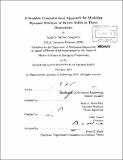| dc.contributor.advisor | Raúl A. Radovitzky. | en_US |
| dc.contributor.author | Seagraves, Andrew Nathan | en_US |
| dc.contributor.other | Massachusetts Institute of Technology. Dept. of Mechanical Engineering. | en_US |
| dc.date.accessioned | 2011-05-23T17:59:16Z | |
| dc.date.available | 2011-05-23T17:59:16Z | |
| dc.date.copyright | 2010 | en_US |
| dc.date.issued | 2010 | en_US |
| dc.identifier.uri | http://hdl.handle.net/1721.1/62997 | |
| dc.description | Thesis (S.M.)--Massachusetts Institute of Technology, Dept. of Mechanical Engineering, 2010. | en_US |
| dc.description | Cataloged from PDF version of thesis. | en_US |
| dc.description | Includes bibliographical references (p. 133-140). | en_US |
| dc.description.abstract | In this thesis a new parallel computational method is proposed for modeling threedimensional dynamic fracture of brittle solids. The method is based on a combination of the discontinuous Galerkin (DG) formulation of the continuum elastodynamic problem with Cohesive Zone Models (CZM) of fracture. In the proposed framework, discontinuous displacement jumps are allowed to occur at all element boundaries in the pre-fracture regime in a manner similar to "intrinsic" cohesive element methods. However, owing to the DG framework, consistency and stability of the finite element solution are guaranteed prior to fracture. This in stark contrast to the intrinsic cohesive element methods which suffer wave propagation and stability issues as a result of allowing discontinuous displacement jumps in the pre-fracture regime without properly accounting for them in the weak statement of the problem. In the new method, a fracture criterion is evaluated at all element boundaries throughout the calculation and upon satisfaction of this criterion, cracks are allowed to nucleate and propagate in the finite element mesh, governed by a cohesive tractionseparation law (TSL). This aspect of the method is similar to existing "extrinsic" cohesive element methods which introduce new fracture surfaces in the mesh through the adaptive insertion of cohesive elements subsequent to the onset of fracture. Typically this requires the mesh topology to be modified on-the-fly, a process which is highly complex and hinders the scalability of parallel implementations. However, for the DG method, discontinuities exist at element boundaries from the start of the calculation and so modifications of the mesh topology are unnecessary for introducing new fracture surfaces. As a result, the parallel computational framework is highly scalable and algorithmically simple. In this thesis, the formulation and numerical implementation of the method is described in detail. The method is then applied to simulate two practical problems. First a ceramic spall test is simulated. In this example, the DG method is shown to accurately capture the propagation of longitudinal elastic waves and the formation of a spall plane. Mesh dependency of the predicted spall plane and the dissipated cohesive energy is investigated for refined meshes resolving the size of the fracture process zone and the results are shown to be highly mesh-sensitive for the range of mesh sizes used. The spall test is also simulated using an existing intrinsic cohesive approach which is shown to alter the propagation of elastic stress waves, leading to the spurious result that no spallation occurs. In a second numerical example, the proposed DG method is applied to simulate high-velocity impact of an unconfined ceramic plate with a rigid spherical projectile. The method is shown to capture some of the basic fundamental aspects of the impact response of unconfined ceramics including the formation of conical and radial cracking patterns. | en_US |
| dc.description.statementofresponsibility | by Andrew Nathan Seagraves. | en_US |
| dc.format.extent | 140 p. | en_US |
| dc.language.iso | eng | en_US |
| dc.publisher | Massachusetts Institute of Technology | en_US |
| dc.rights | M.I.T. theses are protected by
copyright. They may be viewed from this source for any purpose, but
reproduction or distribution in any format is prohibited without written
permission. See provided URL for inquiries about permission. | en_US |
| dc.rights.uri | http://dspace.mit.edu/handle/1721.1/7582 | en_US |
| dc.subject | Mechanical Engineering. | en_US |
| dc.title | A scalable computational approach for modeling dynamic fracture of brittle solids in three dimensions | en_US |
| dc.type | Thesis | en_US |
| dc.description.degree | S.M. | en_US |
| dc.contributor.department | Massachusetts Institute of Technology. Department of Mechanical Engineering | |
| dc.identifier.oclc | 720663630 | en_US |

